Click on images to enlarge
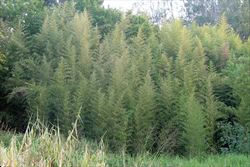
infestation (Photo: Sheldon Navie)

habit (Photo: Sheldon Navie)

habit (Photo: Sheldon Navie)
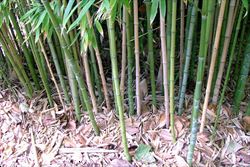
upright stems (Photo: Sheldon Navie)
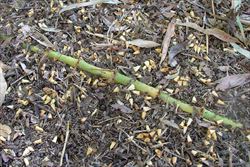
partially exposed creeping underground stem (Photo: Sheldon Navie)
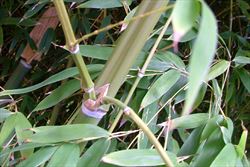
grooved stem above branches (Photo: Sheldon Navie)
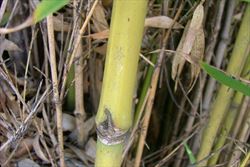
close-up of yellowish-coloured older stem (Photo: Sheldon Navie)
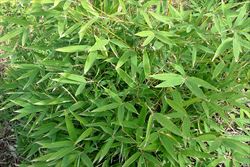
leaves (Photo: Sheldon Navie)
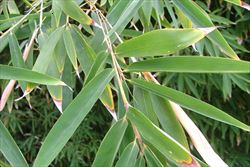
leaves (Photo: Sheldon Navie)

close-up of leaves showing constricted stalk-like bases (Photo: Sheldon Navie)

young shoots emerging from creeping underground stems (Photo: Sheldon Navie)
Scientific Name
Phyllostachys aurea Rivière & C. Rivière
Synonyms
Bambusa aurea hort. ex Rivière & C. RivièreBambusa aurea SieberPhyllostachys bambusoides Siebold & Zucc. var. aurea (Rivière & C. Rivière) Makino
Family
Gramineae (South Australia)Poaceae (Queensland, New South Wales, the ACT, Victoria, Tasmania, Western Australia and the Northern Territory)
Common Names
bamboo, fish-pole bamboo, fishpole bamboo, golden bamboo, stick bamboo, yellow bamboo
Origin
This species is native to some parts of China (i.e. Fujian and Zhejiang provinces).
Cultivation
Widely cultivated as a garden ornamental in Australia.
Naturalised Distribution
Golden bamboo (Phyllostachys aurea) has become naturalised in some parts of south-eastern Queensland and in several locations along the coast of New South Wales. It has also been recorded as naturalised near Perth in south-western Western Australia.
Also naturalised in Indonesia, New Zealand, southern USA (i.e. California, Oregon, Texas, Louisiana, Mississippi, Arkansas, Alabama, Florida, Georgia, Tennessee, South Carolina, North Carolina, Virginia and Maryland), Hawaii and La Reunion.
Habitat
Mainly a weed of sub-tropical and warmer temperate regions that is problematic in untended areas, near gardens, along roadsides and waterways and in urban bushland.
Habit
A long-lived (i.e. perennial) bamboo with upright stems (i.e. erect canes) usually growing 2-8 m tall, but occasionally reaching up to 12 m in height. Plants form dense or loose clumps and spread rapidly via creeping underground stems (i.e. rhizomes), with the upright stems being produced from their joints (i.e. nodes).
Distinguishing Features
- a loosely clumping bamboo with yellowish or golden-coloured mature stems.
- it spreads rapidly via creeping underground stems which produce upright stems from their joints.
- the stems are grooved above where the side branches emerge.
- the base of the elongated leaf blade is very narrow and stalk-like in appearance.
- it rarely if ever produces flowers or seeds.
Seedling
Seedlings of this species are not seen, as naturalised plants reproduce vegetatively.
Stems and Leaves
The stems (i.e. canes) are upright (i.e. erect) and turn form green when they are young to greenish-yellow or golden-yellow in colour as they mature. They are banded with horizontal rings at the joints (i.e. nodes) and are grooved lengthwise (i.e. longitudinally) above where the side branches are produced. These stems are hollow between the joints (i.e. nodes) and are usually 2-3 cm thick. The distance between each joint (i.e. the internode) is usually 8-20 cm long and there is often a white powdery substance present on the stem just below each joint (i.e. node). However, the lowermost joints (i.e. nodes) on each stem are usually closer together and they are often also slanted (i.e. obliquely inclined), thereby giving the base of the stem an irregular zig-zagged appearance.
The leaves are clustered and produced on short shoots which grow from the joints (i.e. nodes) on the branches. They consist of a leaf sheath (25-35 mm long), which surrounds the stem, and a spreading leaf blade. The base of the leaf blade is very narrow and stalk-like in appearance (i.e. pseudo-petiolate). Leaf sheaths are mostly hairless (i.e. glabrous), except near their margins, and where the sheath meets the leaf blade there is a tiny membranous structure (about 1 mm long) topped with long hairs (i.e. a ciliated ligule). On either side of this structure there are sometimes also 1-3 larger bristles (i.e. setae). The leaf blades (5-15 cm long and 5-22 mm wide) are elongated (i.e. lanceolate) in shape, may be either hairless (i.e. glabrous) or softly hairy (i.e. pubescent), and have rough (i.e. scabrous) but entire margins.
Flowers and Fruit
Flowers and seeds are very rarely, if ever, produced in Australia and so are not described here.
Reproduction and Dispersal
This plant reproduces vegetatively via suckers from its proliferous creeping underground stems (i.e. rhizomes).
It quickly spreads outwards from deliberate garden plantings and pieces of its root system (i.e. rhizomes) can also be dispersed in soil and dumped garden waste.
Environmental Impact
Golden bamboo (Phyllostachys aurea) is regarded as an environmental weed Queensland, New South Wales and the ACT.
Legislation
This species is declared under legislation in the following states and territories:
- ACT: C4 - prohibited - a pest plant whose supply is prohibited in the ACT.
- New South Wales: Class 3 - a regionally controlled weed. The relevant local control authority must be promptly notified of the presence of this weed and it must be fully and continuously suppressed and destroyed (on Lord Howe Island only). Class 4 - a locally controlled weed. The growth and spread of this species must be controlled according to the measures specified in a management plan published by the local control authority and the plant may not be sold, propagated or knowingly distributed (in the Blue Mountains, Hornsby, Hunters Hill, Ku-ring-gai, Lane Cove, Manly, Mosman, Newcastle, North Sydney, Parramatta, Pittwater, Ryde, Warringbah and Willoughby local authority areas). This declaration also applies to all rhizomatous bamboos (i.e. Phyllostachys spp.).
- Western Australia: Unassessed - this species is declared in other states or territories and is prohibited until assessed via a weed risk assessment (throughout the entire state).
Similar Species
Golden bamboo (Phyllostachys aurea ) is very similar to madake (Phyllostachys bambusoides) and black bamboo (Phyllostachys nigra), and relatively similar to giant reed (Arundo donax). These species can be distinguished by the following differences:
- golden bamboo (Phyllostachys aurea) has greenish-yellow or golden coloured mature stems that are usually 2-3 cm thick. These stems have a distinctive groove running lengthwise from above where the side branches are produced. Its relatively small leaf blades (up to 15 cm long) have a short stalk-like (i.e. pseudo-petiolate) constriction at their base and sometimes a few bristles (i.e. setae) are present near the top of the leaf sheath. Flowers are very rarely produced.
- madake (Phyllostachys bambusoides) has greenish or yellowish coloured mature stems that are usually 6-20 cm thick. These stems have a distinctive groove running lengthwise from above where the side branches are produced. Its relatively small leaf blades (up to 10 cm long) have a short stalk-like (i.e. pseudo-petiolate) constriction at their base and several black bristles (i.e. setae) are present near the top of the leaf sheath. Flowers are very rarely produced.
- black bamboo (Phyllostachys nigra) has blackish or purplish-black coloured mature stems that are usually 1-4 cm thick. These stems have a distinctive groove running lengthwise from above where the side branches are produced. Its relatively small leaf blades (up to 12 cm long) have a short stalk-like (i.e. pseudo-petiolate) constriction at their base and sometimes a few bristles (i.e. setae) are present near the top of the leaf sheath. Flowers are very rarely produced.
- giant reed (Arundo donax) has greenish coloured stems that are up to 4 cm thick. These stems are rounded and do not have any lengthwise grooves. Its very large leaves (up to 80 cm long) are not constricted at the base of the leaf blade. Flowers are regularly borne in very large, feathery, whitish coloured open panicles at the tops of the stems (i.e. culms).

